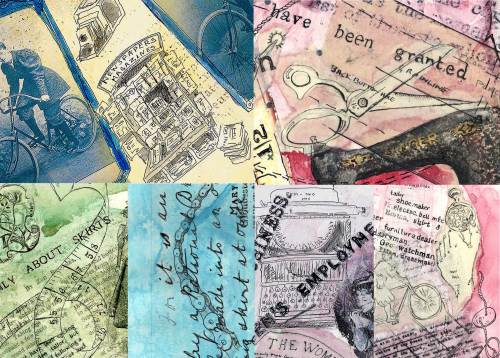Discovering Bikes and Bloomers
June 4, 2014 by aliceangus
Over the last few weeks I have been drawing and painting a series works to be printed on silk and wool for a set of unique textile linings for Victorian ladies cycling garments; commissioned for the Freedom of Movement research project created by sociologist Katrina Jungnickel who is based at Goldsmiths, University of London. The drawings are inspired by Kats in-depth research and tell some of the stories behind each patent, the woman who invented it and the social, technological, physical and cultural challenges that early women cyclists had to face .
Through much of my work with Proboscis collaborating with communities, geographers, technologists and social scientists I’ve become interested in how drawing in public or amongst researchers can be a catalyst for conversation, observation and new analysis, revealing hidden connections and sparking alternative ways to interpret ideas and research. So, rather than being isolated from Kats research in my studio I decided to take the work to Kat’s space in the Sociology Department at Goldsmiths, and for the conversation this sparked to inform the content and feel of each drawing as it developed. Kat has a keen interest in making, craft and collaboration so at any time there was drawing, sewing, film-making, photography and desk based academic research all going on in the space. The finished linings are the a record of, and result of those intense drawing activities as well as an interpretation of the research.
One of the features of the cycling garments that attracted me to this project is that they convert from one type of garment to another. A long skirt might be folded, gathered or lifted up to above the knee by some mechanism of cords, buttons or hooks, to reveal bloomers worn underneath or perhaps a long coat on top; in another patent a skirt is taken off, to reveal bloomers, and worn as a cycling cape. In previous projects I’ve explored drawing and textiles, creating images that change or are revealed by the movement of the fabric so it was interesting to now do this with such rich research tied to the form of a historical garment and in conversation with the researcher and her team.
I was surprised to find out how controversial it was for women to cycle (particularly wearing bloomers), they were shouted and jeered at, refused entry to cafes, were socially shunned and had dirt thrown at them. The women who invented these garments had to be highly creative and balance the need for modesty with the need for free movement of the limbs and safety from fabric catching in the mechanism of the bicycle. Despite the privileged backgrounds of the very early cyclists (machines were expensive) I think these women must have had to display great courage and strength of purpose to push against convention, adopting and campaigning for women’s freedom to be accepted as cyclists, to race on cycles and wear clothing that allowed them more freedom.
The garments themselves will be worn and used for storytelling and presenting the research. You can see them in an exhibition at Look Mum No Hands from 7pm on the 13 June 2014 find out more at bikesandbloomers.com
Comments
2 Responses to “Discovering Bikes and Bloomers”




Bikes and Bloomers http://t.co/yo1zcEj6fC
Bikes and Bloomers http://t.co/yo1zcEj6fC http://t.co/V5GfZT6jdc